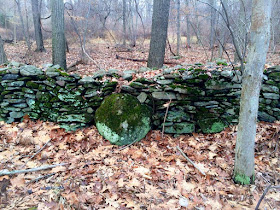From the Case Book of Sherlock Stones
(All photo
credits go to John Martin ~ https://www.facebook.com/Strong-Wind-Photography-by-John-A-Martin-1602232716687052/
- with overlays on the same by myself and my consultant Sherlock Stones)
Consider for a
moment this photo below, posted on a Social Media page that is a sort of
discussion group for what is defined as Ceremonial Stone Landscapes:
Actually, it is
only one photo of two posted photos, which were accompanied by the
photographer’s words, “2 different turtles in a wall? Looks like it to me.”
Here’s the second:
Having been
interested in this sort of thing – the idea that Indigenous People of Turtle
Island, as they called it, created stone constructions well before 1492 – for
long enough to be considered a “crack pot” by all but a tiny number of
archaeologists as well as friends and family members, I offered up the opinion
that perhaps this wall is a Great Serpent Petroform (or Geoglyph), offering up my own
desecration of the original photos to emphasize the opinion:
(I interpret the second as “slit-eyed” and “dreaming,” an idea once suggested to me by a rock art expert.)
Checking in
with my associate Sherlock Stones, I show him the photos, let him know that
various people have made some observations about this stone wall, postulated
that it may be Indigenous in origin etcetera, as well as shared with him a site
drawing (little knowing I was at the wrong site and off by 20 miles) made by the man who took the photographs and who offered the interpretation
that some boulders incorporated into the wall may be effigies representing
Turtle Heads that I contend may rather be Serpent Heads in a representation of one of many Great Serpents, since there is an absence of anything resembling a carapace - or feet.
I expect some validation in the form of praise for my observations, but Stones merely shrugs, reaching for his pouch and pipe. A silent moment passes.
"Stones!" I exclaim, "The boulders may indeed suggest the zoomorphic, probably reptilian I'd wager, but observe the smaller stones (he gives me a brief sharp look as I say that) - er, the shape of those cobbles I mean - used around it, indeed much like the lozenge-shaped scales of a rattlesnake!"
I place another photo on the low table between us:
“Why can’t they
be both?” Sherlock asks, shrugging his shoulders. “Surely you know these Indigenous Native American Great Serpents are notorious
shape-shifters. Do you know the Indian legend of the turtle who shape-shifts into a
Great Serpent?”
“No, I don’t,” I
admit - and then ask, “How does it go?”
“I haven’t the
foggiest,” Stones replies. “I’m not an expert on Lenni Lenape legends, but that
doesn’t mean such a story never existed. Perhaps it’s recorded or perhaps not. In
fact, that story may be recorded in the stonework of this very stonewall! Consider
it a homework assignment! Whatever the outcome, it is still a possibility!”
As he lights his pipe, I change the subject a
little, tell him that someone, a stone mason who lives down by the CT shore but
originally from England coincidentally, has asked the question, “Which came
first, the boulder or the stone wall?” Sherlock tells me further observations
are necessary in order to answer that. “We can’t assume that the boulder rests
on soil, although that is one possibility. Observe the photo that shows three
large boulders of similar size about equal distance apart incorporated into
that row-like concentration of stones (as he says this he circles them,
unasked, in yellow on the printed out page), hardly a natural occurrence and a
coincidence? I think not!!” Stones goes on to say, “A careful excavation by a
qualified Archaeologist, samples taken from below the bouldersand analyzed may reveal which is true of a number of possibilities: These
boulders may rest on bedrock or a buried layer of wall below the surface of the
soil or they may be held in position by stones propping it on either side to
keep them from rolling, which by definition would be a part of the wall –
neither a before or after “Chicken/Egg Situation” but more of a simultaneous
occurrence.”
Sherlock Stones
puffs on his pipe, “Still it is all speculation until you do some soil testing
and arrive upon an informed scientific estimate as to when the first of these
stones were placed here in such a fashion.”
“What tests would
those be?” I ask.
“I haven’t the
foggiest,” he replies. “I’m not an expert in soil science.”
https://en.wikipedia.org/wiki/Luminescence_dating
Luminescence dating refers to a group of methods of determining how long ago mineral grains were last exposed to sunlight or sufficient heating. It is useful to geologists and archaeologists who want to know when such an event occurred. It uses various methods to stimulate and measure luminescence.
It includes techniques such as optically stimulated luminescence (OSL), infrared stimulated luminescence (IRSL), and thermoluminescence dating (TL). "Optical dating" typically refers to OSL and IRSL, but not TL.
https://en.wikipedia.org/wiki/Luminescence_dating






No comments:
Post a Comment